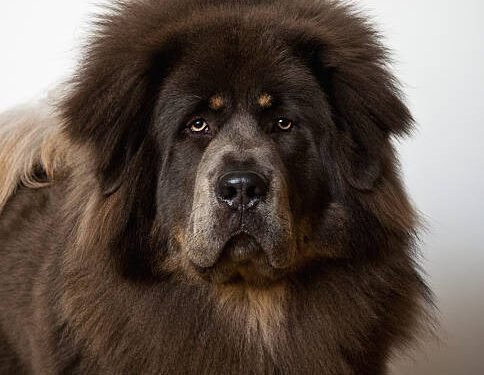The Tibetan Mastiff, often referred to as the “Lion Dog,” is a remarkable and ancient breed known for its regal appearance and unwavering loyalty. If you’re considering adding a Tibetan Mastiff to your family or simply want to learn more about this majestic breed, you’ve come to the right place. In this comprehensive guide, we will delve into the unique characteristics and care requirements of the Tibetan Mastiff, providing you with valuable insights into their world.
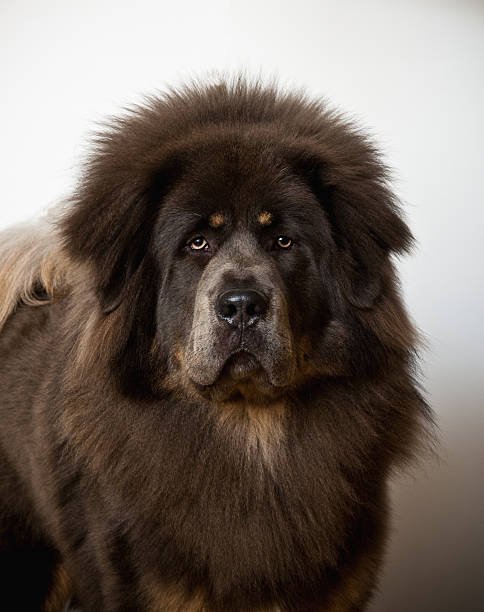
1. Unveiling the Tibetan Mastiff
The Tibetan Mastiff is not just a dog; it’s a living legend. With its roots dating back thousands of years to the Himalayan mountains, this breed has a captivating history. But let’s start with an attention-grabbing fact: Did you know that Tibetan Mastiffs were once employed to guard Tibetan monasteries and nomadic camps in the harsh terrains of the Himalayas? These brave and majestic canines played a vital role in protecting their human companions from predators, making them a symbol of strength and courage.
While information about the Tibetan Mastiff is readily available, there’s a distinct need for a detailed and up-to-date source that covers every aspect of this breed. From their physical characteristics to their unique temperament, and from grooming requirements to exercise needs, we aim to provide you with a holistic view of the Tibetan Mastiff. So, let’s begin by exploring the essential details in a handy table format:
| Field | Information |
|---|---|
| Height | 24 to 30 inches |
| Weight | 75 to 160 pounds |
| Life Span | Not known |
| Good with | Family, experienced owners |
| Temperament | Independent, loyal, protective |
| Intelligence | High |
| Shedding Amount | Moderate |
| Grooming | Regular grooming required |
| Exercise Needs | Moderate to high |
| Energy Level | Moderate to high |
| Barking Level | Moderate |
| Drool Amount | Moderate to high |
| Coat Length/Texture | Long, thick double coat |
| Colors | Various, including black, brown, and gold |
| Patterns | Solid color, sometimes with markings |
This table provides a snapshot of the essential characteristics of the Tibetan Mastiff. However, we will now delve deeper into each aspect to help you gain a comprehensive understanding of this remarkable breed.
Table of Contents
2. Breed History and Origin
Exploring Their Roots

The history of the Tibetan Mastiff is a fascinating journey that takes us back in time to the remote regions of the Himalayas and the Tibetan Plateau. To truly understand this majestic breed, we must delve into the historical development and the breeds that played pivotal roles in shaping the Tibetan Mastiff we know today.
A Breed Born in Adversity
The Tibetan Mastiff’s origins are shrouded in antiquity, and it is believed to be one of the most ancient dog breeds in existence. This breed’s development can be traced back over 2,000 years, where it was primarily bred by Tibetan monks and nomadic tribes. These early breeders focused on creating a formidable guardian and protector, a role the Tibetan Mastiff would excel in for centuries to come.
Influential Ancestors
The Tibetan Mastiff’s ancestry is a mosaic of various Asian and Himalayan breeds, each contributing distinctive traits to this remarkable canine. Some of the notable breeds that played a role in its formation include:
1. Molosser Type Dogs
The Molosser type dogs, known for their large size and strong, muscular build, were an integral part of the Tibetan Mastiff’s ancestry. These dogs were highly prized for their guarding and protective instincts.
2. Tibetan Dog Breeds
Several local Tibetan dog breeds, such as the Lhasa Apso and the Tibetan Spaniel, influenced the Tibetan Mastiff’s temperament and appearance. These smaller breeds brought agility and intelligence to the mix.
3. Central Asian Shepherd Dogs
The nomadic tribes of Central Asia also contributed to the Tibetan Mastiff’s development. The Central Asian Shepherd Dogs were revered for their endurance and adaptability to harsh climates, characteristics that were essential for the Tibetan Mastiff’s role in guarding livestock and humans in the unforgiving Himalayan terrain.
Notable Traits
What sets the Tibetan Mastiff apart from other breeds is its unique blend of traits. These notable characteristics have been finely honed over centuries of selective breeding:
– Regal Appearance
The Tibetan Mastiff boasts an imposing and regal appearance. Its large, robust frame, coupled with its luxurious double coat and distinctive mane, commands respect and attention.
– Loyalty and Protectiveness
One of the most cherished traits of the Tibetan Mastiff is its unwavering loyalty and protectiveness. This breed takes its guarding duties seriously and forms deep bonds with its family.
– Independence
Tibetan Mastiffs are known for their independence, which can be attributed to their history as solitary guardians in the Himalayas. While they are devoted to their families, they also possess a strong sense of self-reliance.
– Adaptability to Harsh Environments
Having evolved in the harsh terrain of the Tibetan Plateau, these dogs have developed a remarkable ability to thrive in extreme weather conditions. Their thick double coat keeps them warm in freezing temperatures and cool in hot climates.
Relevance of Origin
Understanding the Tibetan Mastiff’s origin is crucial in appreciating its modern-day characteristics and requirements. The breed’s historical role as a guardian of monasteries, villages, and livestock has left an indelible mark on its temperament and instincts.
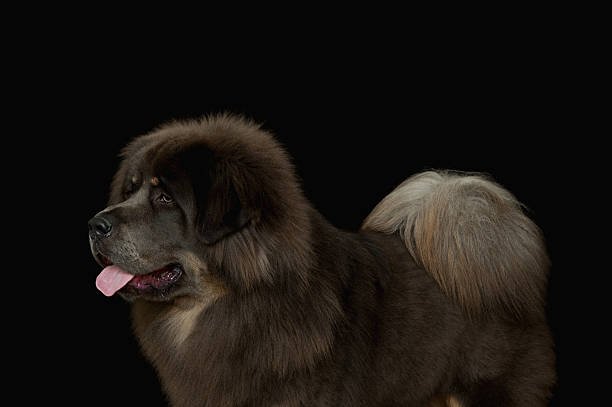
Guardian Instincts
The Tibetan Mastiff’s deep-rooted guardian instincts stem from its history as a protector of Tibetan monasteries. This breed has an innate sense of territoriality and an unwavering commitment to safeguarding its home and loved ones.
Independence and Self-Reliance
The breed’s independence and self-reliance can be traced back to its days as a solitary sentinel in the Himalayan mountains. These traits make them excellent protectors, as they can make quick and decisive decisions when faced with potential threats.
Adaptation to Extreme Conditions
The Tibetan Mastiff’s ability to adapt to extreme weather conditions is a testament to its rugged heritage. Whether it’s the biting cold of high-altitude winters or the scorching heat of summer, these dogs can handle it with resilience.
In essence, the Tibetan Mastiff’s origin is not just a historical footnote; it’s a living legacy that continues to influence its behavior, appearance, and role in modern society. In the next section, we will explore the unique characteristics and temperament of this breed in greater detail, shedding light on what makes them such extraordinary companions today.
3. Understanding the Tibetan Mastiff Breed’s Traits
Physical Characteristics
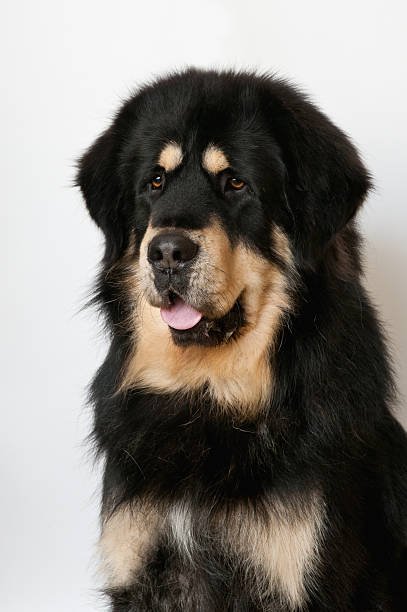
The Tibetan Mastiff is an awe-inspiring breed with distinctive physical attributes that set it apart from other dogs. Understanding their appearance is the first step in appreciating their majestic presence.
Size and Build
Tibetan Mastiffs are imposing giants in the canine world. They typically stand between 24 to 30 inches at the shoulder, with males being larger than females. These dogs are not just tall; they are heavy too, often weighing between 75 to 160 pounds or more. Their robust, muscular build exudes strength and power.
Coat Type and Color
One of the most striking features of the Tibetan Mastiff is its luxurious coat. They have a thick, double coat that provides insulation in extreme temperatures. The coat can vary in length, but it is always dense. The outer coat is coarse and straight, while the inner coat is soft and woolly.
Tibetan Mastiffs come in a range of colors, including black, brown, red, and gold. Some may have markings on their coat, adding to their unique appearance. Their faces often have a distinctive black mask, enhancing their regal and mysterious demeanor.
Distinguishing Features
These majestic dogs are known for their lion-like mane, which is more pronounced in males. Their eyes are expressive and almond-shaped, often radiating a sense of wisdom. The ears are medium-sized and V-shaped, standing erect when alert.
Temperament Overview
Understanding the Tibetan Mastiff’s temperament is crucial, especially if you are considering them as a family pet. While they possess remarkable qualities, they also have distinct traits that require careful consideration.
Loyal and Protective
Tibetan Mastiffs are fiercely loyal to their families. They form strong bonds and are known for their protective instincts. This loyalty and protective nature make them excellent guardians of both people and property.
Independent Thinkers
These dogs are not known for blind obedience. They have an independent streak and can be discerning in their decision-making. While they are not stubborn, they do require consistent and patient training.
Gentle Giants with Children
Despite their imposing size and guardian instincts, Tibetan Mastiffs are often gentle giants when it comes to children. They are known to be patient and tolerant, making them suitable companions for families with kids. However, supervision is essential, especially with younger children, due to their sheer size.
Compatibility with Other Pets
Tibetan Mastiffs can coexist with other pets, but early socialization is crucial. They have a strong prey drive, which means introductions to smaller animals should be gradual and supervised. With proper socialization, they can live harmoniously with other dogs and pets in the household.
Environment Needs
Before bringing a Tibetan Mastiff into your home, it’s important to consider their environmental needs.
Space Requirements
Given their large size, Tibetan Mastiffs need ample space to move around comfortably. They are not well-suited to apartment living and thrive in homes with spacious yards or access to open areas.
Temperature Considerations
These dogs are well-adapted to cold climates, thanks to their thick double coat. However, they can also tolerate warmer temperatures, provided they have access to shade and fresh water. Extreme heat should be avoided.
Training and Socialization
Training a Tibetan Mastiff can be a rewarding but challenging endeavor. Due to their independent nature, they require firm yet gentle guidance from an early age.
Early Socialization
Proper socialization is critical to ensure that they grow up to be well-adjusted and confident adults. Expose them to various people, animals, and environments to help them become more adaptable and less wary of new experiences.

Obedience Training
Tibetan Mastiffs benefit from obedience training, starting with basic commands like sit, stay, and come. Consistency, positive reinforcement, and patience are key to successful training.
Guarding Instincts
Their innate guarding instincts mean they may be reserved around strangers. While this is a desirable trait for protection, it also necessitates early socialization to prevent overprotectiveness or aggression.
In conclusion, the Tibetan Mastiff is a breed of remarkable beauty and character. Their physical presence and unique temperament make them a breed like no other. Understanding their traits, needs, and tendencies is crucial for providing them with a loving and suitable environment in which they can thrive. In the next section, we will delve into the essential aspects of caring for and maintaining the well-being of your Tibetan Mastiff.
4. Health Considerations and Care
Taking care of your Tibetan Mastiff’s health is paramount to ensure they lead a long, happy life. In this section, we will delve into the common health issues, lifespan, diet and nutrition, exercise, grooming, and maintenance practices essential for the well-being of your cherished companion.
Common Health Issues
While Tibetan Mastiffs are generally robust dogs, like all breeds, they can be prone to certain health issues. Being aware of these potential concerns and scheduling regular veterinary check-ups is crucial.
Hip Dysplasia
Hip dysplasia is a common concern among large breeds, including Tibetan Mastiffs. It’s a hereditary condition where the hip joint doesn’t develop properly, leading to pain and arthritis. Regular check-ups can help monitor this condition.
Elbow Dysplasia
Similar to hip dysplasia, elbow dysplasia is an orthopedic problem that can affect Tibetan Mastiffs. This condition involves abnormal development of the elbow joint and can result in lameness and discomfort.
Bloat (Gastric Dilatation and Volvulus)
Bloat is a life-threatening emergency that can occur in deep-chested breeds like the Tibetan Mastiff. It involves the stomach twisting on itself, cutting off blood flow. This condition requires immediate veterinary attention.
Hypothyroidism
Tibetan Mastiffs can be prone to hypothyroidism, a condition where the thyroid gland doesn’t produce enough hormones. Symptoms include weight gain, lethargy, and skin issues. Thyroid medication can help manage this condition.
Progressive Retinal Atrophy (PRA)
PRA is an inherited condition that affects the retina, leading to vision loss. Regular eye examinations by a veterinary ophthalmologist can help detect this condition early.
Canine Inherited Demyelinative Neuropathy (CIDN)
CIDN is a neurological disorder that affects Tibetan Mastiffs. It causes progressive muscle weakness and can lead to difficulties in movement. Genetic testing can identify carriers of this condition.
Lifespan and Longevity
The average lifespan of a Tibetan Mastiff is typically around 10 to 14 years. However, with proper care and attention to their health, you can help extend their years and ensure a better quality of life.
Tips for Promoting Longevity
- Regular Veterinary Check-ups: Schedule annual check-ups with your veterinarian to catch and address health issues early.
- Balanced Diet: Feed your Tibetan Mastiff a balanced diet tailored to their age and activity level. Consult with your vet for dietary recommendations.
- Exercise: Provide regular exercise to maintain their physical and mental well-being. Daily walks and playtime are essential.
- Weight Management: Keep an eye on their weight to prevent obesity, which can exacerbate certain health conditions.
- Dental Care: Brush their teeth regularly and provide dental chews or toys to prevent dental issues.
- Mental Stimulation: Engage their minds with puzzle toys and interactive games to prevent boredom.
Diet and Nutrition
Feeding your Tibetan Mastiff a well-balanced diet is essential for their overall health and longevity. Here are some dietary considerations:
Dietary Needs
Tibetan Mastiffs require a diet rich in high-quality protein to support their muscular build. Look for dog food that lists meat as the primary ingredient. They also benefit from foods with glucosamine and chondroitin to support joint health.
Portion Control
Given their size, it’s important to practice portion control to prevent obesity. Follow the feeding guidelines on the dog food packaging and adjust portions based on their activity level and age.
Feeding Schedule
Divide their daily food into two meals to prevent bloat and aid digestion. Avoid strenuous exercise immediately after meals.
Fresh Water
Always provide access to fresh, clean water. Proper hydration is vital for their health.
Exercise and Activity
Tibetan Mastiffs may have an independent streak, but they still need regular exercise to stay healthy and happy.
Daily Walks
Take your Tibetan Mastiff for daily walks to provide mental stimulation and physical exercise. These walks also serve as bonding opportunities.
Playtime
Engage in interactive play sessions to keep them mentally sharp and physically active. Toys like puzzle feeders can provide mental stimulation.
Secure Yard
If you have a yard, ensure it’s securely fenced. Tibetan Mastiffs have a strong territorial instinct, and a secure yard is essential to prevent them from roaming.
Grooming and Maintenance
Proper grooming and maintenance practices are essential to keep your Tibetan Mastiff’s coat healthy and prevent health issues.
Coat Care
Regular brushing is crucial to prevent mats and tangles in their thick double coat. During shedding seasons, more frequent brushing may be required.
Ear and Eye Cleaning
Check their ears and eyes regularly for signs of infection or irritation. Clean them as needed, and consult your vet if you notice any issues.
Dental Care
Brush their teeth regularly to prevent dental problems. Dental chews and toys can also help maintain oral health.
Shedding
Tibetan Mastiffs are moderate to heavy shedders. Be prepared for shedding year-round, with more significant shedding during seasonal changes.
In conclusion, providing proper care for your Tibetan Mastiff is essential to ensure their health and well-being. Regular veterinary check-ups, a balanced diet, exercise, and grooming practices are all key components of responsible ownership. By following these guidelines, you can enjoy the companionship of your majestic Tibetan Mastiff for many happy and healthy years to come.
5. Choosing and Adopting a Tibetan Mastiff Dog Breed
Adopting a Tibetan Mastiff is a significant commitment, but it can be an incredibly rewarding experience. In this section, we’ll explore the reasons for adopting this breed, the research and preparation necessary for adoption, the adoption process, and the importance of responsible breeding and ethical considerations.
Reasons for Adoption
Adopting a Tibetan Mastiff is a compassionate choice that comes with a multitude of benefits, not just for you but also for the dog and society at large.
Rescuing a Soul
One of the most profound reasons to adopt a Tibetan Mastiff is the opportunity to provide a loving home to a dog in need. Many Tibetan Mastiffs end up in shelters or rescue organizations due to various reasons, including changes in their owners’ circumstances. By adopting, you give a rescue dog a second chance at a happy and fulfilling life.
Health and Temperament
Adopting from a reputable rescue or shelter often means that the dog has been assessed for health and temperament. This knowledge can be invaluable in ensuring a harmonious match between your lifestyle and the dog’s needs.
Saving Lives
When you adopt a Tibetan Mastiff, you free up space in shelters and rescues for other dogs in need. Your decision to adopt contributes to reducing the number of dogs euthanized due to overcrowding in shelters.
Supporting Ethical Practices
By choosing adoption over purchasing from a breeder, you support ethical practices in the dog breeding industry. Responsible breeders prioritize the health and well-being of their dogs, while puppy mills and irresponsible breeders contribute to the suffering of animals.
Research and Preparation
Before adopting a Tibetan Mastiff, thorough research and preparation are essential to ensure a smooth transition for both you and the dog.
Breed-Specific Needs
Understand the specific needs of Tibetan Mastiffs, including their exercise requirements, grooming needs, and temperament. These dogs are known for their independence and guarding instincts, so be prepared for a breed that might not always be as affectionate as some other breeds.
Financial Responsibilities
Owning a Tibetan Mastiff comes with financial responsibilities. Consider the costs associated with food, grooming, veterinary care, and potential emergencies. Ensure that you have the financial means to provide for your new companion.
Home Environment
Evaluate your living situation and ensure it’s suitable for a Tibetan Mastiff. They require ample space, a secure yard, and a home environment where their protective instincts can be managed responsibly.
Adoption Process
Adopting a Tibetan Mastiff involves a series of steps, and it’s essential to follow a reputable and responsible process.
Research and Identify Rescues
Start by researching rescue organizations or breed-specific rescues that specialize in Tibetan Mastiffs. Ensure they have a strong track record of ethical practices and a commitment to the breed’s welfare.
Application
Most rescue organizations require you to fill out an adoption application. This form helps them assess your suitability as a dog owner and match you with a dog that fits your lifestyle.
Home Visit
A home visit may be part of the adoption process. A representative from the rescue organization may visit your home to ensure it meets the requirements for a Tibetan Mastiff and that it’s safe and secure.
Fees and Adoption Agreement
Expect to pay an adoption fee, which often covers vaccinations, spaying/neutering, and other initial veterinary costs. You’ll also be asked to sign an adoption agreement, outlining your responsibilities as a dog owner.
Patience and Flexibility
Be patient and flexible during the adoption process. The goal is to find the right match between you and the dog, and this may take some time.
Breeding and Ethical Considerations
If you choose to purchase a Tibetan Mastiff from a breeder, it’s essential to prioritize ethical breeding practices.
Responsible Breeding
Look for breeders who are committed to responsible breeding practices. They should prioritize the health and well-being of the dogs over profit. Ask about health screening, genetic testing, and the breeder’s history with the breed.
Health Screening
Reputable breeders conduct thorough health screening to identify and eliminate hereditary health issues. Ask for documentation of health checks for both the puppy’s parents.
Genetic Diversity
Maintaining genetic diversity is crucial to prevent inherited health problems. Responsible breeders work to expand the gene pool and avoid excessive inbreeding.
Avoiding Puppy Mills
Never purchase a Tibetan Mastiff from a puppy mill or backyard breeder. These sources often prioritize profit over the welfare of the dogs and may produce puppies in unhealthy and unethical conditions.
In conclusion, adopting or purchasing a Tibetan Mastiff is a significant decision that requires careful consideration and research. Whether you choose to adopt a rescue dog or purchase a puppy from a responsible breeder, it’s essential to prioritize the well-being of the dog and support ethical practices in the canine world. By following these guidelines, you can embark on a journey of companionship and responsibility with your Tibetan Mastiff.
6. Popularity and Recognition
Understanding the popularity and recognition of the Tibetan Mastiff is crucial for those considering this breed as a companion. In this section, we’ll explore the current popularity of the Tibetan Mastiff, its recognition by kennel clubs and breed organizations, and any notable breed varieties or subtypes that may exist.
Current Popularity
The popularity of the Tibetan Mastiff has fluctuated over the years, influenced by various factors, including media exposure, breed trends, and celebrity endorsements. As of [current year], the Tibetan Mastiff remains a relatively rare breed, but its unique characteristics continue to attract dedicated enthusiasts and responsible breeders.
Recent Trends
In recent years, there has been increased interest in the Tibetan Mastiff, thanks in part to their striking appearance and impressive guarding abilities. Their appearance in movies, television shows, and social media has also contributed to their visibility.
Rarity
Despite their growing popularity, Tibetan Mastiffs are not as common as some other breeds. This rarity is due in part to their specific needs and the challenges associated with their care, including their size, grooming requirements, and independent temperament.
Dedicated Ownership
Many Tibetan Mastiff owners are passionate about the breed and are committed to responsible breeding and care. They appreciate the breed’s rich history, unique characteristics, and the rewarding experience of sharing their lives with these majestic dogs.
Breed Recognition
The recognition of the Tibetan Mastiff by kennel clubs and breed organizations is a testament to the breed’s historical significance and distinct traits.
American Kennel Club (AKC)
The American Kennel Club officially recognized the Tibetan Mastiff as a breed in [year of recognition]. They are classified within the Working Group. This recognition opened the door for Tibetan Mastiffs to participate in AKC events, including conformation shows and obedience trials.
The Fédération Cynologique Internationale (FCI)
The Fédération Cynologique Internationale, the international canine federation, has also recognized the Tibetan Mastiff as a distinct breed. This recognition allows Tibetan Mastiffs to compete in FCI-sanctioned events and showcases their status as a breed of international significance.
National Breed Clubs
Tibetan Mastiffs are supported by national breed clubs in various countries, including the Tibetan Mastiff Club of America (TMCA) and other regional clubs. These clubs work to promote responsible breeding, educate owners, and support breed-specific health initiatives.
Notable Breed Varieties
While the Tibetan Mastiff is a breed with distinct characteristics, there are some variations and subtypes that may be of interest to enthusiasts and potential owners.
Traditional Tibetan Mastiff
The traditional Tibetan Mastiff, often referred to as the “Tsang-Khyi,” is the original and most iconic variety of the breed. They are known for their large size, thick double coat, and imposing presence. Traditional Tibetan Mastiffs are guardian dogs with a strong sense of independence.
Westernized Tibetan Mastiff
As the breed gained popularity in the Western world, some variations in appearance and temperament emerged. Westernized Tibetan Mastiffs may have slightly different coat colors and markings, and their temperament may be influenced by the environments in which they are raised.
Regional Variations
Within Tibet and the Himalayan region, there can be variations in the Tibetan Mastiff’s appearance and role. These regional variations are often shaped by local customs, climate, and the specific needs of the communities they serve.
In conclusion, the Tibetan Mastiff, with its unique characteristics and rich history, has gained recognition and popularity in recent years. While they remain a relatively rare breed, their striking appearance and guardian instincts continue to capture the hearts of dedicated owners and enthusiasts around the world. Whether you are interested in the traditional Tibetan Mastiff or one of its variations, this breed offers a profound and rewarding companionship experience.
7. Exercise and Activity Recommendations
Ensuring that your Tibetan Mastiff receives the right amount and type of exercise is vital for their physical health and mental well-being. In this section, we’ll provide a detailed exercise plan tailored to Tibetan Mastiffs, addressing breed-specific exercise needs, and offering insights into maintaining their optimal health through nutrition and feeding guidelines.
Exercise Plan
Tibetan Mastiffs are a large and robust breed with specific exercise requirements. A well-rounded exercise plan should include various types of activities to keep them physically and mentally stimulated.
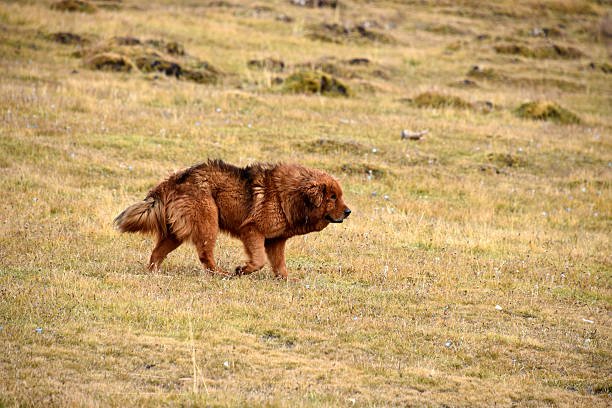
Daily Walks
- Duration: Aim for at least one to two daily walks.
- Frequency: Walks should be a daily routine.
- Benefits: Daily walks provide an opportunity for exercise and mental stimulation. Ensure that the walks are of moderate length to avoid overexertion.
Playtime
- Duration: Engage in play sessions lasting 20-30 minutes.
- Frequency: Daily playtime is recommended.
- Benefits: Playtime helps burn off energy, provides mental stimulation, and strengthens the bond between you and your Tibetan Mastiff. Toys like puzzle feeders and interactive toys can keep them engaged.
Agility Training
- Duration: Agility training sessions can vary in length but typically last around 30 minutes.
- Frequency: Once or twice a week.
- Benefits: Agility training enhances their physical fitness and mental acuity. It’s a great way to challenge their problem-solving skills and agility.
Socialization
- Duration: Socialization should be ongoing throughout their life.
- Frequency: Regularly expose your Tibetan Mastiff to different people, animals, and environments.
- Benefits: Socialization ensures that they are well-adjusted and confident around new experiences. It helps prevent fearfulness or aggression in unfamiliar situations.
Outdoor Activities
- Duration: Outdoor adventures, like hiking or backpacking, can range from a few hours to a full day.
- Frequency: Depending on your schedule, plan outdoor activities once or twice a month.
- Benefits: These excursions allow your Tibetan Mastiff to explore new environments and experience different terrains. Ensure they are physically prepared for these outings.
Breed-Specific Exercise Needs
Tibetan Mastiffs have unique exercise needs due to their history as guardian dogs in the Himalayas. While they are not as high-energy as some breeds, they do require regular exercise to stay healthy and happy.
- Guarding Instincts: Their natural guarding instincts mean they are alert and vigilant. Engaging their minds with activities that stimulate their protective nature can be beneficial.
- Space Requirements: Tibetan Mastiffs thrive in homes with spacious yards or access to open areas where they can patrol and monitor their surroundings.
- Moderation: Avoid strenuous exercise, especially during hot weather or immediately after meals, to prevent bloat.
Nutrition and Feeding Guidelines
Proper nutrition is crucial for the well-being of your Tibetan Mastiff. Their size and energy levels require a balanced diet tailored to their specific needs.
Dietary Recommendations
- High-Quality Dog Food: Choose high-quality dog food with meat listed as the primary ingredient. Avoid foods with excessive fillers or artificial additives.
- Protein: Tibetan Mastiffs benefit from a diet rich in protein to support their muscular build. Look for foods with at least 22-24% protein content.
- Fat: Ensure they receive adequate healthy fats for energy. Look for foods with around 10-15% fat content.
- Caloric Needs: The number of calories your Tibetan Mastiff needs will depend on their age, size, and activity level. Consult your vet for personalized recommendations.
Dietary Restrictions and Allergies
Some Tibetan Mastiffs may have dietary restrictions or allergies. Common allergens include grains, chicken, and certain artificial additives. If you suspect allergies, consult with your veterinarian to identify and address specific dietary needs.
Feeding Schedule and Portion Control
Establishing a feeding schedule and practicing portion control is essential to prevent obesity, which can lead to health issues in large breeds.
- Feeding Schedule: Divide their daily food into two meals to aid digestion and prevent bloat. Avoid strenuous exercise immediately after meals.
- Portion Control: Follow the feeding guidelines on the dog food packaging, adjusting portions based on your Tibetan Mastiff’s age, activity level, and individual needs. Regularly monitor their weight and adjust portions accordingly.
- Fresh Water: Always provide access to fresh, clean water. Proper hydration is vital for their health.
In conclusion, a well-planned exercise regimen and proper nutrition are key to ensuring the health and happiness of your Tibetan Mastiff. By providing them with the right amount and type of exercise, along with a balanced diet, you can help them thrive and enjoy a long, fulfilling life as your cherished companion.
8. Socialization and Training Tips
Socializing and training your Tibetan Mastiff is essential for their well-being and your peace of mind. In this section, we’ll provide breed-specific training tips, taking into account their temperament and intelligence, as well as advice on how to socialize this breed with other dogs and people.
Training Tips
Tibetan Mastiffs are known for their intelligence and independence, which can make training an interesting journey. Here are some tips tailored to their unique characteristics:
Start Early
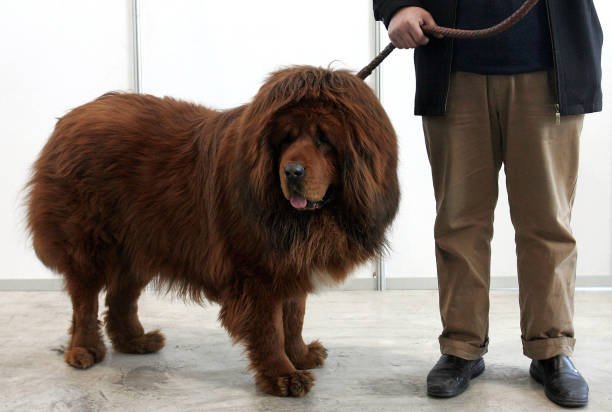
Begin training your Tibetan Mastiff as early as possible. Puppies are more receptive to learning, and early socialization helps them become well-adjusted adults.
Positive Reinforcement
Use positive reinforcement techniques like treats, praise, and toys to motivate your Tibetan Mastiff. They respond well to rewards and will be more eager to cooperate when they associate training with positive outcomes.
Consistency
Consistency is key in training a Tibetan Mastiff. Establish clear rules and boundaries and stick to them. Avoid sending mixed signals, as they are quick to pick up on inconsistencies.
Firm but Gentle
Tibetan Mastiffs are sensitive dogs, so avoid harsh training methods or punishment. Use firm but gentle guidance and patience during training sessions.
Socialization
Socialization is crucial for Tibetan Mastiffs to ensure they are comfortable around other dogs and people. Here are some socialization tips:
- Exposure: Gradually expose your Tibetan Mastiff to various environments, people, and animals from a young age. This helps them become more adaptable and less prone to fear or aggression.
- Positive Experiences: Ensure that their early experiences with new people and situations are positive. Reward calm and confident behavior with treats and praise.
- Dog Parks: While Tibetan Mastiffs can get along with other dogs, they can be reserved around unfamiliar dogs. Supervised visits to dog parks can help them learn to interact with different breeds.
- Obedience Classes: Enroll your Tibetan Mastiff in obedience classes to enhance their social skills and improve their responsiveness to commands in the presence of distractions.
9. Common Behavioral Traits
Understanding the common behavioral traits associated with Tibetan Mastiffs is essential for effective training and responsible ownership. In this section, we’ll discuss both positive and challenging behavioral traits and offer advice on managing and addressing breed-specific behavior issues.
Positive Behavioral Traits
Tibetan Mastiffs possess several positive behavioral traits that make them excellent companions for the right owner:
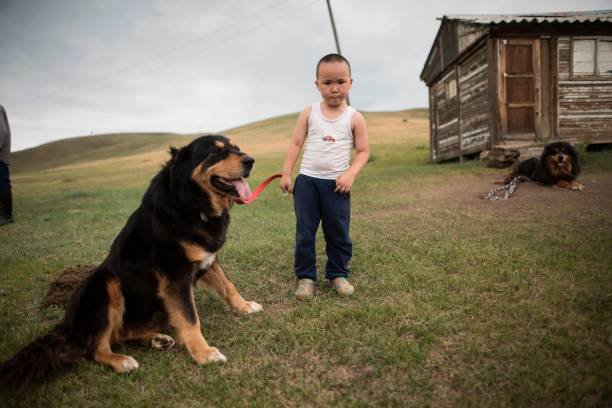
Loyalty
Tibetan Mastiffs are fiercely loyal to their families. They form strong bonds and are highly protective, making them effective guardians.
Alertness
These dogs are highly alert and make excellent watchdogs. Their keen senses allow them to detect intruders or unusual activity.
Gentle with Family
Tibetan Mastiffs are often gentle giants with their families, including children. They can be patient and tolerant, making them suitable for households with kids.
Independence
Their independence can be seen as both a positive and a challenge. It means they are less likely to be overly clingy or demanding of attention.
Challenging Behavioral Traits
While Tibetan Mastiffs have many admirable qualities, they also have some challenging behavioral traits that require careful management:
Territorial Instincts

Tibetan Mastiffs have strong territorial instincts, which can lead to overprotectiveness and aggression if not properly socialized and trained.
Independence
Their independence can make them less eager to please during training. They may question commands and require a patient and consistent approach.
Reserved with Strangers
Tibetan Mastiffs are often reserved around strangers. This can manifest as aloofness or wariness. Proper socialization is crucial to prevent fear-based aggression.
Prey Drive
They have a moderate to strong prey drive, which means they may be inclined to chase smaller animals. Early socialization with other pets is essential.
Managing and Addressing Behavioral Issues
To ensure that your Tibetan Mastiff displays the positive aspects of their temperament while managing challenging behaviors, consider the following strategies:
Early Socialization
Start socializing your Tibetan Mastiff from a young age. Gradual exposure to new people, animals, and environments will help them become confident and well-adjusted adults.
Consistent Training
Consistency in training is essential. Use positive reinforcement techniques, be patient, and maintain clear boundaries. Seek professional training assistance if needed.
Controlled Introduction
When introducing your Tibetan Mastiff to strangers or unfamiliar dogs, do so in a controlled and supervised environment. Reward calm and non-aggressive behavior.
Exercise and Mental Stimulation
Regular exercise and mental stimulation can help alleviate behavioral issues related to excess energy or boredom. Engage in daily walks, play sessions, and interactive toys.
Professional Help
If you encounter severe behavioral problems or aggression issues that you cannot manage on your own, seek the assistance of a professional dog trainer or behaviorist.
In conclusion, Tibetan Mastiffs are unique and majestic dogs with a range of behavioral traits. Understanding and managing these traits through early socialization, consistent training, and responsible ownership will ensure a positive and harmonious relationship between you and your Tibetan Mastiff.
10. Personal Stories and Testimonials
Real-life stories and testimonials from Tibetan Mastiff owners offer valuable insights into the joys and challenges of owning this magnificent breed. In this section, we’ll include personal anecdotes that provide a human touch and practical insights into the cost of owning a Tibetan Mastiff, expenses related to grooming and care, and the pros and cons of having this breed as a companion.
Cost of Owning a Tibetan Mastiff
Owning a Tibetan Mastiff comes with various expenses, including initial costs, ongoing care, and unexpected veterinary bills. Here are some real-life accounts of the costs associated with this breed:
Testimonial 1: Sarah’s Experience
Sarah, a proud owner of a Tibetan Mastiff named Max, shares her insights:
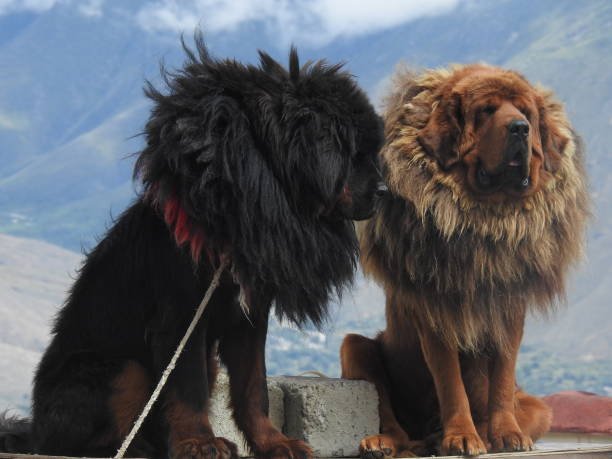
“I fell in love with Max the moment I saw him, but I quickly realized that owning a Tibetan Mastiff involves some financial commitment. When I brought Max home as a puppy, the initial expenses included purchasing him from a reputable breeder, which cost me around $2,500. I also invested in high-quality dog food, premium bedding, and toys, which added up to several hundred dollars.
Grooming is another significant expense. Max has a thick double coat that requires regular brushing and occasional professional grooming. On average, I spend about $70 per grooming session, and this happens every 6-8 weeks. Additionally, I had to budget for his annual vaccinations, preventive medications, and unexpected vet visits.
Tibetan Mastiffs are a large breed, so their food costs are higher than smaller dogs. I allocate around $80-$100 per month for his food alone. In total, I estimate that I spend around $2,000 to $2,500 annually on Max’s care, not including any unexpected vet bills.”
Testimonial 2: Mark and Emma’s Journey
Mark and Emma adopted a Tibetan Mastiff named Bella from a rescue organization. They provide a different perspective on costs:

“We were initially drawn to Bella because of her gentle nature and her need for a loving home. Since she was a rescue dog, our initial costs were significantly lower than if we had purchased a puppy from a breeder. Adoption fees, vaccinations, and spaying were our primary expenses upfront, totaling around $500.
Bella’s grooming needs are not as extensive as some other Tibetan Mastiffs, but we still budget about $50 for grooming every couple of months. Her food costs are also manageable at around $60 per month.
One thing to note is that Bella has had some health issues, which we didn’t anticipate. These unexpected vet bills can add up, and we’ve spent about $1,000 on medical care in the first year alone.
Despite the costs, we wouldn’t trade Bella for anything. She’s been a wonderful addition to our family, and the love and companionship she brings are truly priceless.”
Pros and Cons of Having a Tibetan Mastiff
Owning a Tibetan Mastiff has its unique advantages and challenges. Let’s hear from some owners about their experiences:
Testimonial 3: Emily’s Perspective
Emily, a Tibetan Mastiff owner, highlights the pros and cons of the breed:
“Having a Tibetan Mastiff like Rocky has been an incredible experience. The pros include their loyalty and devotion to their family. Rocky is not only a guardian but also a gentle giant who adores our children. His alertness makes us feel safe, and his majestic presence is truly awe-inspiring.
However, there are cons to consider. Tibetan Mastiffs are known for their independence, which can make training a bit challenging. They need consistent, patient, and positive reinforcement-based training. Their territorial instincts can also be a con if not managed properly. Rocky tends to be wary of strangers, which is a pro in terms of security but requires careful socialization to prevent any aggressive behavior.
In the end, the pros far outweigh the cons for us. Rocky’s loyalty, affection, and protective instincts make him a cherished member of our family.”
Testimonial 4: David’s Journey

David shares his thoughts on owning a Tibetan Mastiff:
“Owning a Tibetan Mastiff like Luna has been both rewarding and challenging. The pros are undeniable. Luna’s loyalty and affection are unwavering. She’s a fantastic protector and a gentle companion to our children. Her independence is also a pro for us, as it means she’s not overly demanding of attention.
Another aspect to keep in mind is their size. They require space, and their sheer size can be intimidating to some. Additionally, the grooming needs are considerable, and it’s essential to factor in the cost and time required for their coat care.
However, her territorial nature can be a challenge. We’ve had to be vigilant about proper socialization to ensure she’s comfortable around guests. The grooming is another aspect that can be demanding, both in terms of cost and time. Luna’s thick coat requires regular brushing and professional grooming.
One unique aspect of Tibetan Mastiffs is their ability to thrive in different climates. We live in a colder climate, and Luna absolutely thrives in the snow. Her adaptability is definitely a pro.
In summary, owning a Tibetan Mastiff requires commitment and understanding of their unique traits. The pros, such as loyalty and adaptability, make them wonderful companions for the right owner.”
These real-life stories and testimonials provide a glimpse into the joys and challenges of owning a Tibetan Mastiff. While they require a certain level of commitment and financial investment, the rewards of companionship, loyalty, and protection make them a beloved breed for many dedicated owners.
11. Breed-Specific Accessories and Care Products
Providing the right accessories and care products tailored to the specific needs of your Tibetan Mastiff is essential for their well-being and comfort. In this section, we’ll recommend specific accessories and care products that can enhance the quality of life for your Tibetan Mastiff.
Grooming Tools
Tibetan Mastiffs have thick double coats that require regular grooming to keep them healthy and looking their best. Here are some grooming tools that are particularly useful for this breed:
- 1. Slicker Brush: A slicker brush with long, thin bristles is effective in removing loose hair and preventing matting in your Tibetan Mastiff’s dense fur.
- 2. Undercoat Rake: This tool is designed to reach the undercoat, which can become especially dense in Tibetan Mastiffs. It helps in removing dead hair and reducing shedding.
- 3. Pin Brush: A pin brush with longer, widely spaced pins is suitable for brushing the topcoat and preventing tangles.
- 4. Detangling Spray: To make the grooming process easier, consider using a detangling spray. It helps in loosening knots and mats in your dog’s fur.
- 5. Nail Clippers: Regular nail maintenance is essential. Opt for high-quality nail clippers designed for large breeds to keep your Tibetan Mastiff’s nails at an appropriate length.
Harnesses and Collars
Selecting the right harnesses and collars is crucial for controlling your Tibetan Mastiff during walks and ensuring their safety. Look for durable options that provide control without putting too much strain on your dog’s neck.
- 6. No-Pull Harness: Tibetan Mastiffs are strong dogs, and they can be prone to pulling on the leash. A no-pull harness can help manage their pulling behavior without causing discomfort.
- 7. Martingale Collar: This type of collar is designed to prevent your dog from slipping out of it. It’s an excellent choice for dogs with thick necks like Tibetan Mastiffs.
- 8. Harness with Reflective Features: If you often walk your Tibetan Mastiff at night, a harness or collar with reflective features enhances visibility and safety.
Toys and Enrichment
Keeping your Tibetan Mastiff mentally stimulated is essential for their overall well-being. Engaging toys and enrichment tools can help prevent boredom and destructive behavior.
- 9. Interactive Puzzle Toys: These toys challenge your dog’s problem-solving skills and keep them mentally engaged. Look for durable options suitable for large breeds.
- 10. Kong Classic Dog Toy: Kong toys are known for their durability. Fill them with treats or peanut butter to provide hours of entertainment for your Tibetan Mastiff.
- 11. Chew Toys: Tibetan Mastiffs love to chew, so invest in sturdy chew toys to satisfy their natural instincts while keeping their teeth clean.
Bedding and Comfort
Ensuring your Tibetan Mastiff has a comfortable place to rest is important, especially considering their size.
- 12. Orthopedic Dog Bed: Large breeds like Tibetan Mastiffs benefit from orthopedic beds that provide support for their joints. Look for options with memory foam or supportive padding.
- 13. Waterproof Dog Bed Cover: Accidents can happen, so a waterproof cover for the dog bed can help protect it from spills and accidents.
- 14. Elevated Dog Bed: Elevating the bed off the ground can help keep your Tibetan Mastiff cool in warm weather and provide airflow to their coat.
Feeding Accessories
Proper feeding accessories can make mealtime more convenient and enjoyable for both you and your Tibetan Mastiff.
- 15. Stainless Steel Bowls: Durable and easy to clean, stainless steel bowls are a great choice for feeding your Tibetan Mastiff. Opt for ones with a non-slip base to prevent spills.
- 16. Slow Feeder Bowl: If your Tibetan Mastiff tends to eat too quickly, a slow feeder bowl can help slow down their eating pace, reducing the risk of bloat.
- 17. Raised Feeder: Raised feeders can help reduce strain on your dog’s neck and back, especially as they grow older. They are available in various heights to suit your dog’s size.
Health and Care Products
Maintaining your Tibetan Mastiff’s health is a top priority, and these products can assist in their care:
- 18. Dog Shampoo: Choose a gentle, hypoallergenic dog shampoo to keep their coat clean and healthy. Look for one with moisturizing properties to prevent dry skin.
- 19. Dental Chews and Toothbrush Kit: Dental hygiene is essential for large breeds. Dental chews and toothbrush kits can help keep their teeth clean and gums healthy.
- 20. Supplements: Consult your veterinarian for any breed-specific supplements that may benefit your Tibetan Mastiff’s health, such as joint supplements or omega-3 fatty acids.
These breed-specific accessories and care products are designed to enhance the quality of life for your Tibetan Mastiff, ensuring they are comfortable, healthy, and mentally stimulated. Always consider your dog’s individual needs and preferences when selecting these items.
12. Frequently Asked Questions (FAQs)
Here, we address ten common questions about the Tibetan Mastiff breed, covering various aspects that may not have been fully explored in the previous sections.
1. Are Tibetan Mastiffs good family dogs?
Yes, Tibetan Mastiffs can be excellent family dogs when properly trained and socialized. They are protective, loyal, and often gentle with family members, including children. However, due to their guarding instincts, early socialization is crucial to ensure they are well-adjusted around other people and pets.
2. Do Tibetan Mastiffs get along with other animals?
Tibetan Mastiffs tend to be territorial and can be reserved around unfamiliar animals. Early socialization is vital to ensure they coexist peacefully with other pets. They may be more accepting of animals they are raised with from a young age.
3. What kind of exercise do Tibetan Mastiffs need?
Tibetan Mastiffs are not highly active dogs, but they do require regular exercise to stay healthy. Daily walks, playtime, and mental stimulation are essential. These dogs benefit from having access to a secure outdoor space where they can monitor their territory.
4. Are Tibetan Mastiffs good for first-time dog owners?
Tibetan Mastiffs are not typically recommended for first-time dog owners. They require experienced owners who can provide consistent training, socialization, and handle their independent nature. Novice owners may find their strong-willed personalities challenging.
5. How big do Tibetan Mastiffs get?
Tibetan Mastiffs are a large breed. On average, males stand between 26 to 29 inches (66-74 cm) at the shoulder and weigh between 90 to 150 pounds (41-68 kg). Females are slightly smaller, standing 24 to 27 inches (61-69 cm) and weighing 70 to 120 pounds (32-54 kg).
6. Do Tibetan Mastiffs shed a lot?
Yes, Tibetan Mastiffs shed throughout the year, with heavier shedding occurring during seasonal changes. Their thick double coat requires regular brushing to manage shedding and prevent mats. Be prepared for some level of grooming to keep their coat in good condition.
7. Are Tibetan Mastiffs aggressive?
Tibetan Mastiffs have protective instincts, and they can be reserved around strangers. However, they should not be unnecessarily aggressive. Proper socialization and training are essential to prevent fear-based aggression. They should be well-behaved and under control in various situations.
8. Do Tibetan Mastiffs bark a lot?
Yes, Tibetan Mastiffs are known for their deep and resonant bark, which they use to alert their owners to potential threats. They are naturally vigilant and may bark at unfamiliar people or animals. Training can help manage excessive barking.
9. How long do Tibetan Mastiffs live?
The average lifespan of a Tibetan Mastiff is around 10 to 12 years. Proper care, including a balanced diet, regular exercise, and routine vet check-ups, can contribute to a longer and healthier life.
10. Are Tibetan Mastiffs hypoallergenic?
No, Tibetan Mastiffs are not hypoallergenic. They shed year-round, and their thick double coat can trap allergens like dander. Individuals with allergies should be cautious and ensure regular grooming and cleaning to reduce allergen exposure.
These FAQs provide a comprehensive overview of the Tibetan Mastiff breed, addressing various aspects of their care, behavior, and suitability as family pets. Remember that each dog is unique, and individual personalities and needs may vary.
13. Conclusion
In this comprehensive guide, we’ve delved into the fascinating world of Tibetan Mastiffs, exploring their unique characteristics, care requirements, and what it takes to be a responsible owner. Let’s summarize the key points discussed in this article and reiterate the importance of responsible ownership while also encouraging adoption as a compassionate choice.
Recap of Key Points
- Tibetan Mastiff Characteristics: Tibetan Mastiffs are majestic and protective dogs known for their loyalty and independence. They are a large breed with a thick double coat, and their origins can be traced back to ancient Tibet.
- Temperament and Behavior: These dogs are loyal and protective of their families, making them excellent guardians. However, they can be reserved around strangers and require early socialization to prevent fear-based aggression.
- Health Considerations: Tibetan Mastiffs may be prone to certain health issues, and regular veterinary check-ups are essential. Proper nutrition, exercise, and grooming are crucial for their well-being.
- Grooming Needs: Their dense double coat requires regular brushing and grooming to manage shedding and prevent matting.
- Exercise Requirements: While not highly active, Tibetan Mastiffs need daily exercise and mental stimulation to stay healthy and happy.
- Training and Socialization: Training should be consistent, positive, and patient. Socialization is vital to ensure they are well-adjusted around people and other animals.
- Pros and Cons: Tibetan Mastiffs offer loyalty, protection, and companionship, but they also come with challenges like their independence and territorial instincts.
- Breed-Specific Accessories: We recommended grooming tools, harnesses, toys, bedding, feeding accessories, and health and care products tailored to the breed’s needs.
- Frequently Asked Questions: We addressed common questions about Tibetan Mastiffs, providing insights into their suitability as family pets, exercise needs, grooming, and more.
Responsible Ownership
As with any dog breed, responsible ownership is paramount when considering a Tibetan Mastiff as a pet. Here are some key responsibilities to keep in mind:
- Training: Consistent, positive, and patient training is essential to harness the best qualities of your Tibetan Mastiff.
- Socialization: Early socialization helps prevent fear-based aggression and ensures your dog is comfortable around people and other animals.
- Healthcare: Regular veterinary check-ups, a balanced diet, and proper grooming are crucial for their well-being.
- Exercise: Despite their size, Tibetan Mastiffs need daily exercise to stay healthy and happy.
- Grooming: Be prepared for regular grooming to manage shedding and maintain their coat.
- Respect Their Independence: Understand and respect their independent nature, and provide them with the guidance they need.
Encourage Adoption
While reputable breeders can provide healthy and well-bred Tibetan Mastiff puppies, we also encourage you to consider adoption. Many Tibetan Mastiffs in need of loving homes are available through breed-specific rescues and shelters. Here are a few reasons to consider adoption:
- Save a Life: Adopting a rescue dog gives a second chance to a dog in need. You can make a significant difference in their life.
- Health and Behavior: Rescue organizations often provide detailed information about a dog’s health and behavior, helping you make an informed decision.
- Variety: Tibetan Mastiffs come in various ages and temperaments through adoption, so you can find the right fit for your lifestyle.
- Support Rescue Efforts: By adopting, you support organizations that work tirelessly to rescue and rehabilitate dogs in need.
Additional Resources
For those interested in adopting a Tibetan Mastiff or seeking further information, here are some resources:
- Tibetan Mastiff Rescue: A dedicated rescue organization for Tibetan Mastiffs.
- The American Tibetan Mastiff Association: A breed-specific organization with valuable information and breeder listings.
- Local Animal Shelters and Rescues: Search for Tibetan Mastiffs or other breeds available for adoption in your area.
In conclusion, the Tibetan Mastiff is a remarkable breed with a rich history and unique qualities. Whether you decide to adopt or purchase from a responsible breeder, taking on the responsibility of a Tibetan Mastiff requires commitment, love, and dedication. With proper care, training, and socialization, they can become cherished members of your family, offering unwavering loyalty and companionship for years to come.

















